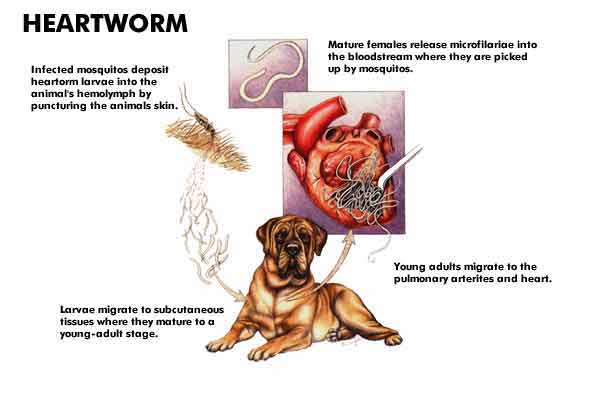Heartworm

What causes heartworm disease?
Heartworm disease (dirofilariasis) is a serious and potentially fatal disease in dogs. It is caused by a worm called Dirofilaria immitis.
Heartworms are found in the heart and large adjacent vessels of infected dogs. The female worm is 6 to 14 inches (2.3 to 5.5 cm) long and 1/8 inch (5 mm) wide; the male is about half the size of the female. One dog may have as many as 300 worms.
How do heartworms get into the heart?
Adult heartworms live in the heart and pulmonary arteries of infected dogs. They have been found in other areas of the body, but this is unusual. They survive up to 5 years and, during this time, the female produces millions of young (microfilaria). These microfilaria live in the bloodstream, mainly in the small blood vessels. The immature heartworms cannot complete the entire life cycle in the dog; the mosquito is required for some stages of the heartworm life cycle. The microfilaria are therefore not infective (cannot grow to adulthood) in the dog, although they do cause problems.
As many as 30 species of mosquitoes can transmit heartworms. The female mosquito bites the infected dog and ingests the microfilariae during a blood meal. The microfilariae develop further for 10 to 30 days in the mosquito and then enter the mouth parts of the mosquito. The microfilariae are now called infective larvae because at this stage of development, they will grow to adulthood when they enter a dog. The mosquito bites the dog where the haircoat is thinnest. However, having long hair does not prevent a dog from getting heartworms.
When fully developed, the infective larvae enter the bloodstream and move to the heart and adjacent vessels, where they grow to maturity in 2 to 3 months and start reproducing, thereby completing the full life cycle.
Return to Articles